Radiator fans, 4-cyl.
| Radiator fans, 4-cyl. |
| One radiator fan (cars without A/C) |
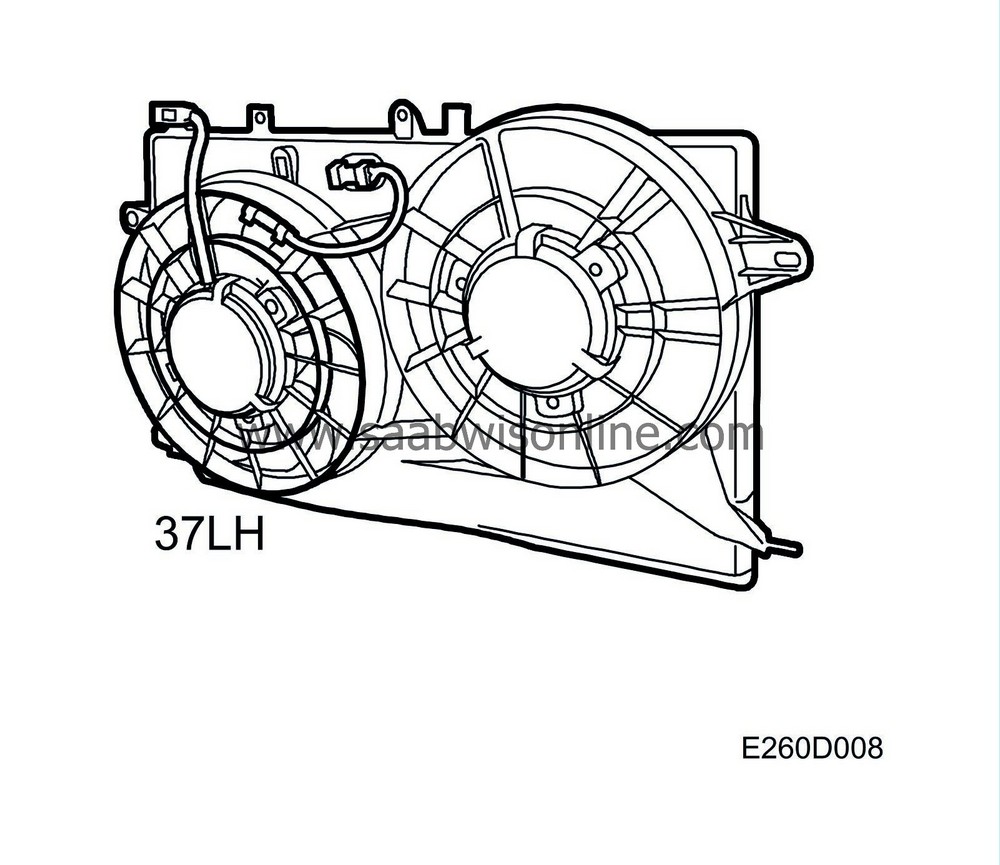
Cars without A/C are fitted with one electric fan mounted behind the radiator. The fan has two speeds, high and low.
The fan is controlled by the DICE system through the following input signal:
| • |
Coolant temperature (bus from TRIONIC)
|
|
The radiator fan is activated when the coolant temperature is the same as or higher than the preprogrammed value (low/high speed).
The DICE unit receives information on the coolant temperature via the bus.
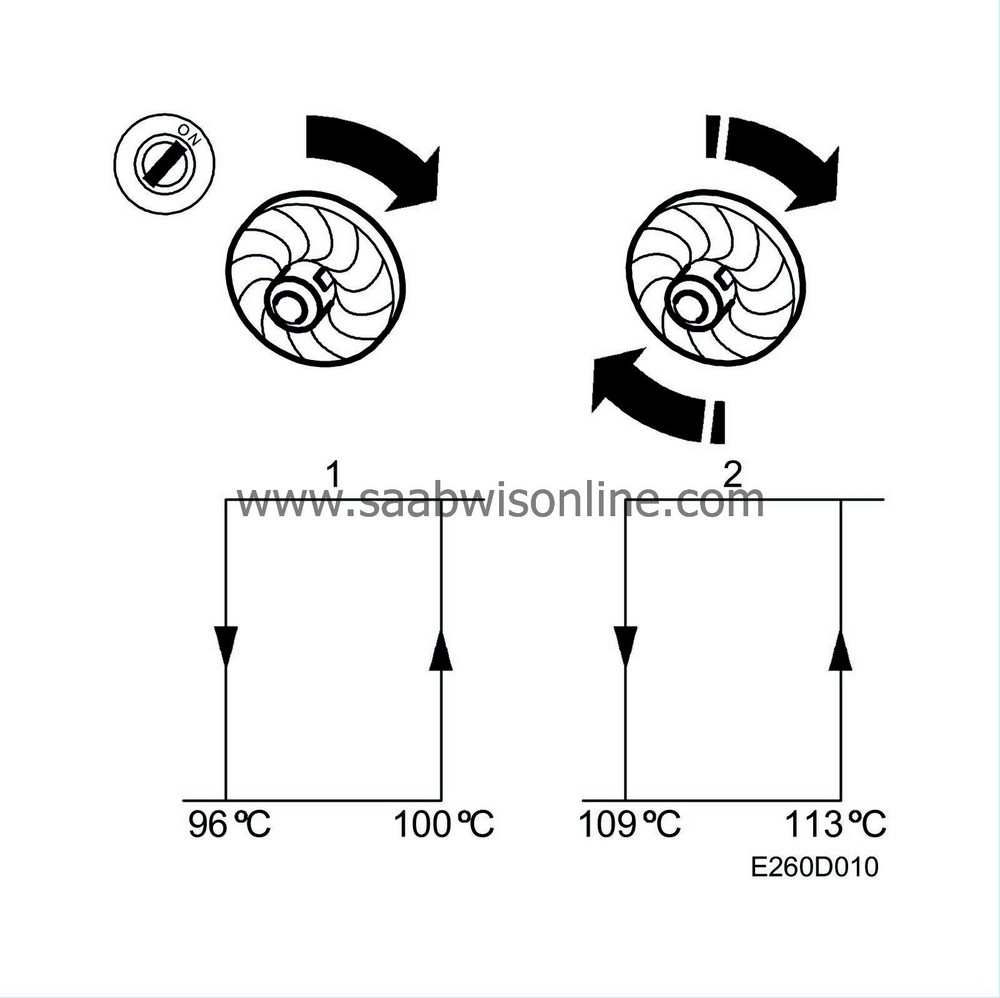
| Two radiator fans (cars with A/C) |

Cars with A/C are fitted with two electric fans mounted behind the radiator. The fans have two speeds, high and low.
The fans are controlled by the DICE unit via the following input signals:
| • |
Coolant temperature (bus from TRIONIC)
|
|
| • |
A/C pressure
|
|
| • |
Car speed (bus from MIU)
|
|
| • |
Outside temperature (bus from SID)
|
|
The radiator fans start in the following cases:
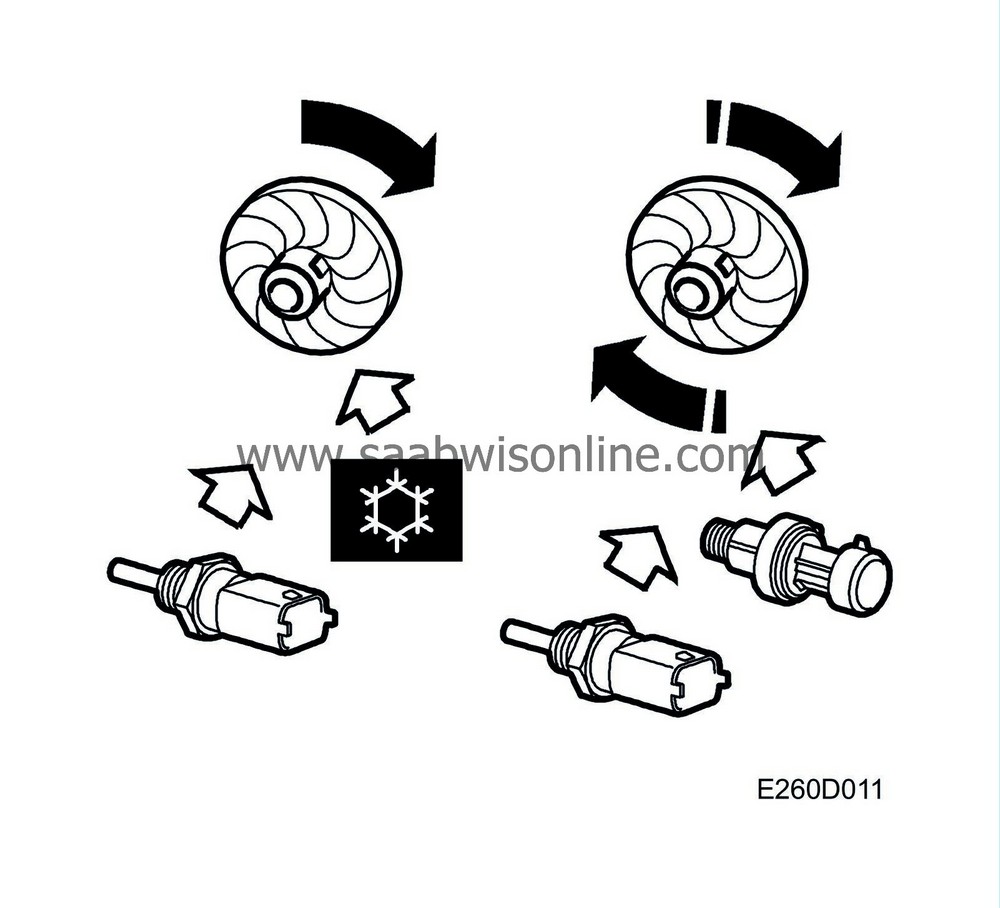
| 1. |
When coolant temperature reaches 100°C the fans start at low speed. If the temperature rises to 113°C they start running at high speed.
|
|
| 2. |
When the A/C compressor is activated, the fans start running at low speed in one of the following cases:
|
|
| • |
Outside temperature higher than 22°C
|
| • |
Vehicle speed below 38 km/h and A/C pressure between 9 and 18 bar.
|
| 3. |
When the A/C compressor is activated, the fans start running at high speed if A/C pressure exceeds 18 bar.
|
|
The DICE receives information on the coolant temperature via the bus. The pressure in the A/C system is obtained via its own pressure sensor.
| Operation, one radiator fan (cars without A/C) |
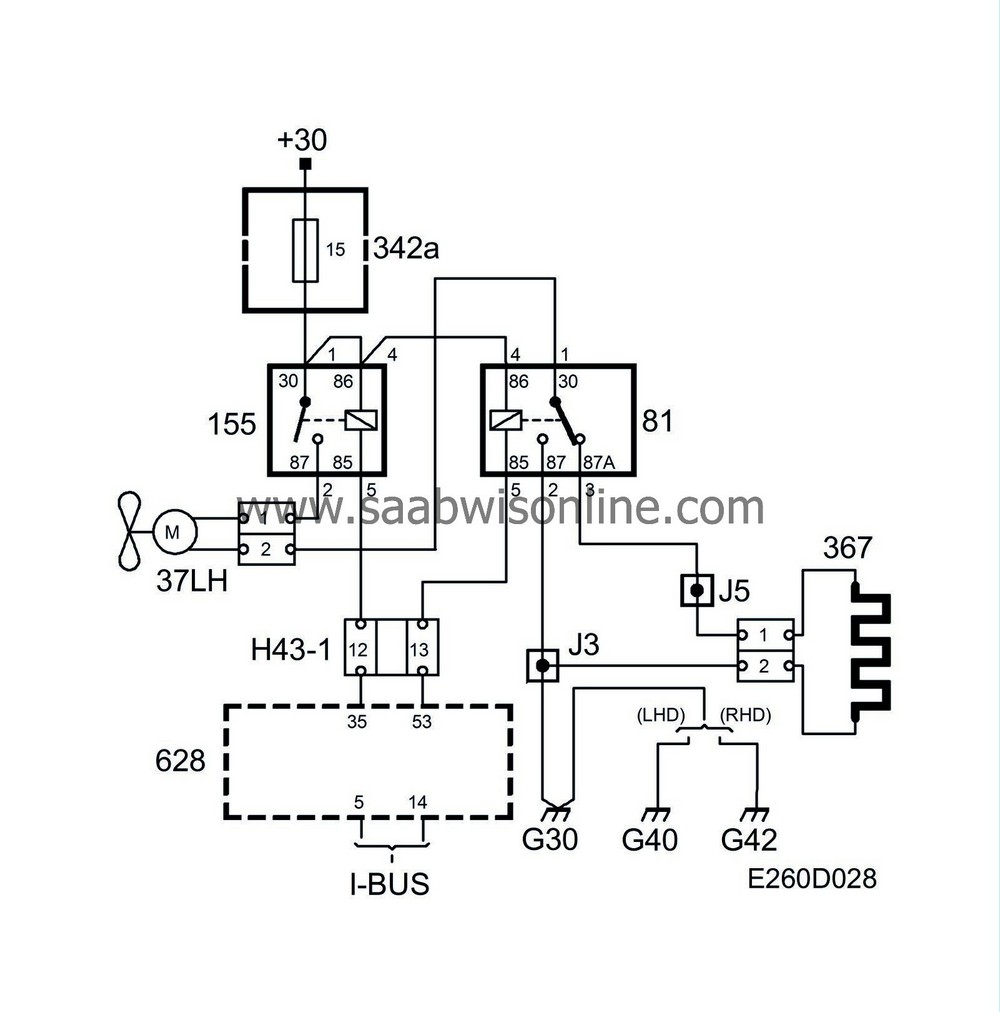
The radiator fan can be run at two speeds, depending on the coolant temperature:
| • |
Low speed
|
|
| • |
High speed
|
|
The radiator fan is controlled by the DICE system via two relays, (155) and (81).
Irrespective of the ignition switch position, power is supplied via fuse 15 to the low speed relay (155).
| • |
Low speed
The DICE applies the value of the coolant temperature which meets the conditions for low speed. The relay (155) is then grounded via pin 35 of the control unit. Power is supplied to the radiator fan which starts running at low speed because the current is reduced by a series resistor (367). |
|
| • |
High speed
The DICE applies the value of the coolant temperature which meets the conditions for high speed. The relay (81) is then grounded via pin 53 of the control unit which means that the radiator fan is grounded directly. Relay (155) is still in the operated state. The radiator fan now runs at high speed. |
|
| Operation, two radiator fans (cars with A/C) |

The radiator fans can be run at two speeds, depending on coolant temperature, A/C pressure, car speed and outside temperature:
| • |
Low speed
|
|
| • |
High speed
|
|
The radiator fans are controlled by the DICE system via three relays: (155), (81) and (396).
Irrespective of the ignition switch position, power is supplied via fuse 15 to relay (155) and relay (81) for low speed running.
| • |
Low speed, only relay (155) operated
The DICE applies the values which meet the conditions for low speed. The relay (155) is then grounded via pin 35 of the control unit. Power is supplied to both radiator fans via relays (155) and (81). The radiator fans start running at low speed because the current is reduced as a result of them being connected in series. |
|
| • |
High speed, all relays operated
The DICE applies the values which meet the conditions for high speed. The relay (81) is then grounded via pin 53 of the control module, which means that the left-hand radiator fan (37 LH) is grounded directly and relay (155) is still in the operated state. Power is then supplied direct to the left-hand radiator fan (37LH) which starts running at high speed. Relay (396) is grounded at the same time, which means that the right-hand radiator fan (37RH) is supplied with power separately and starts running at high speed. The radiator fans are thus connected in parallel. |
|
| Operation with ignition ON |
When the ignition switch is in the ON position, the DICE uses the following information on the bus:
One radiator fan (cars without A/C)
| • |
Coolant temperature (bus from TRIONIC)
|
|
Two radiator fans (cars with A/C)
| • |
Coolant temperature (bus from TRIONIC)
|
|
| • |
A/C pressure
|
|
| • |
Car speed (bus from MIU)
|
|
| • |
Outside temperature (bus from SID)
|
|
| • |
A/C system status (active/inactive)
|
|
The information is used in the DICE to determine whether the radiator fan/fans should be started or stopped.
To maintain idling speed constant, the DICE sends information on the estimated current consumption to the engine management system via the bus. The information is send 0.1 seconds before the DICE starts or stops the radiator fan/fans. The estimated maximum current consumption of the radiator fan/fans is:
One radiator fan (cars without A/C)
| • |
15 A, low speed
|
|
| • |
23 A, high speed
|
|
Two radiator fans (cars with A/C)
| • |
9 A, low speed
|
|
| • |
37 A, high speed
|
|
When the conditions for high speed are fulfilled, low speed should be active for 2 seconds before high speed is activated. If high speed is active and the conditions for stopping both low speed and high speed are fulfilled, high speed is stopped immediately and low speed is stopped after 2 seconds.
| Note | ||
|
High speed cannot be activated until 15 seconds after the ignition has been turned on. |
Diagnostics
If the coolant temperature lies outside the limits or if coolant temperature information is not given, the DICE starts low speed running after 5 seconds. This prevents engine overheating.A diagnostic trouble code is generated in Trionic. For further information refer to Group 2 “Engine management system, Trionic 4-cyl.”, Fault diagnosis
 .
.
The DICE receives information on the coolant temperature from TRIONIC.
The radiator fan/fans are activated as follows:

| 1. |
Low speed
Activated when the coolant temperature reaches 99°C and stopped when the temperature drops to 96°C. |
|
| 2. |
High speed
Activated when the coolant temperature reaches 113°C and stopped when the temperature drops to 109°C. |
|
When A/C is requested, some conditions must be fulfilled in the DICE as well as TRIONIC for the A/C compressor clutch to operate. For further information with regards to A/C and its control, see A/C system .
For further information on the coolant temperature sensor, refer to Coolant temperature sensor .
When the A/C coupling is active, the radiator fans are activated according to the following conditions:
| 1. |
Low speed
Activated when the outside temperature exceeds 22°C and stopped when the outside temperature falls below 20°C. |
|
| 2. |
Low speed
Vehicle speed is below 38 km/h while A/C pressure is between 9 and 18 bar. Low speed running stops when vehicle speed rises above 40 km/h or A/C pressure drops below 7 bar. |
|
| 3. |
High speed
A/C pressure is above 18 bar. High speed running stops when A/C pressure is below 14 bar. |
|
To understand the operation of the radiator fan, it is important to note that it can be activated differently at the same value (within certain preset limits), depending on whether the value is rising or falling.
If coolant temperature is 98°C, for instance, low speed will be activated if the temperature was previously 100°C or above and has now fallen to 98°C. However, if low speed had not been activated and the coolant temperature is 98°C, low speed will not be activated.
| Operation with ignition OFF |
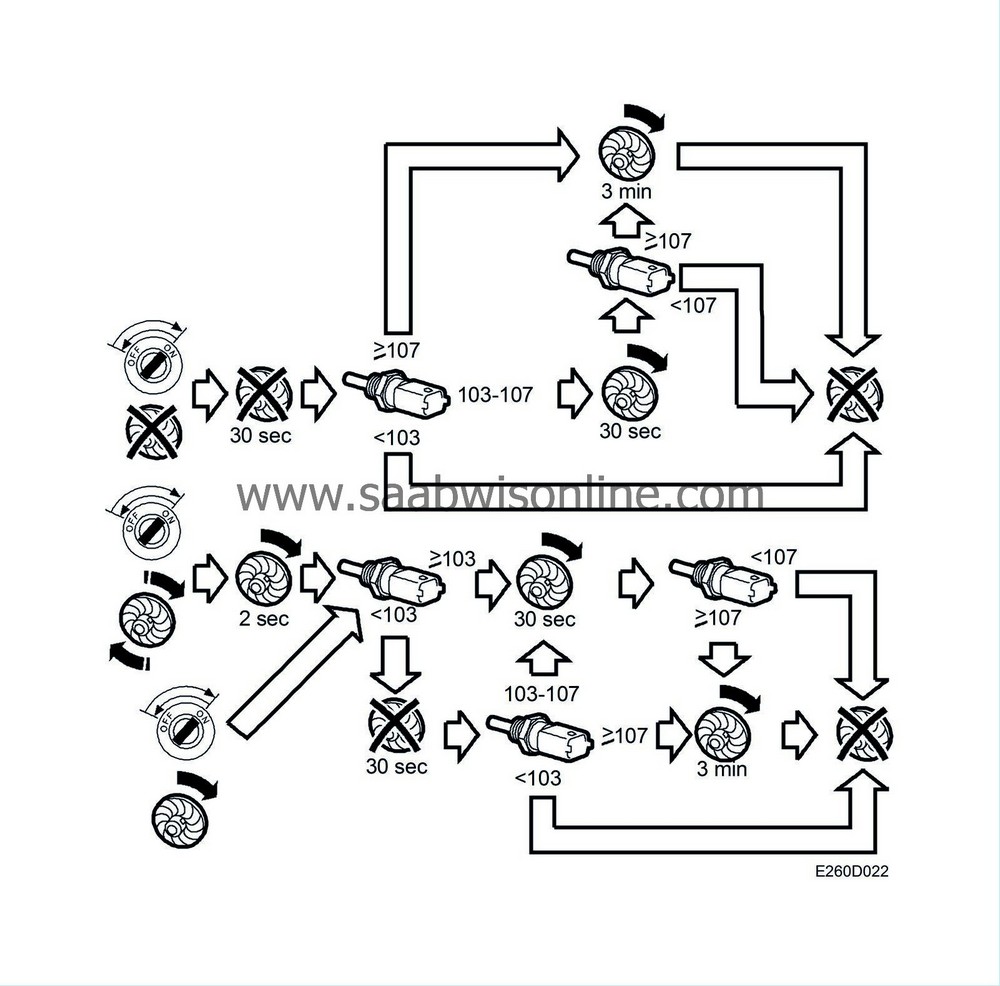
The DICE receives information on the coolant temperature from TRIONIC with the ignition OFF, after 30 seconds and after 1 minute when the ignition switch is in the OFF position.
In order to receive this information, the DICE needs to keep the MIU active for one minute. From this information, the DICE can activate low speed running for a maximum of 3.5 minutes.
Note that only low speed running is activated with the ignition OFF.
Radiator fan does not run when ignition is turned from ON to OFF
30 seconds after ignition OFF:| • |
The radiator fan starts and runs for 3 minutes if the coolant temperature is 107°C or above. After 3 minutes the fan stops.
|
|
| • |
The radiator fan starts and runs for 30 seconds if the coolant temperature is between 103°C and 107°C.
|
|
1 minute after ignition OFF (only if coolant temperature was between 103°C and 107°C 30 seconds after ignition OFF):
| • |
The radiator fan continues to run for 3 minutes if the coolant temperature is 107°C or above.
|
|
| • |
The radiator fan stops if the coolant temperature is below 107°C.
|
|
The radiator fan runs at low speed when ignition is turned from ON to OFF
| • |
The radiator fan continues to run for 30 seconds if the coolant temperature is 103°C or above.
|
|
| • |
The radiator fan stops if the coolant temperature is below 103°C.
|
|
30 seconds after ignition OFF:
| • |
If the radiator fan did not stop when the ignition was turned OFF, it will continue to run for 3 minutes if the coolant temperature is 107°C or above. After 3 minutes the fan will stop. If the coolant temperature is below 107°C the fan will stop.
|
|
| • |
If the radiator fan stopped when the ignition was turned OFF, it will start and run for 3 minutes if the coolant temperature is 107°C or above. After 3 minutes the fan will stop. If the coolant temperature is between 103°C and 107°C, the fan will start and run for 30 seconds. If the coolant temperature is below 103°C the fan will stop.
|
|
1 minute after ignition OFF (only if coolant temperature was between 103°C and 107°C 30 seconds after ignition OFF):
| • |
The radiator fan continues to run for 3 minutes if the coolant temperature is 107°C or above.
|
|
| • |
The radiator fan stops if the coolant temperature is below 107°C.
|
|



